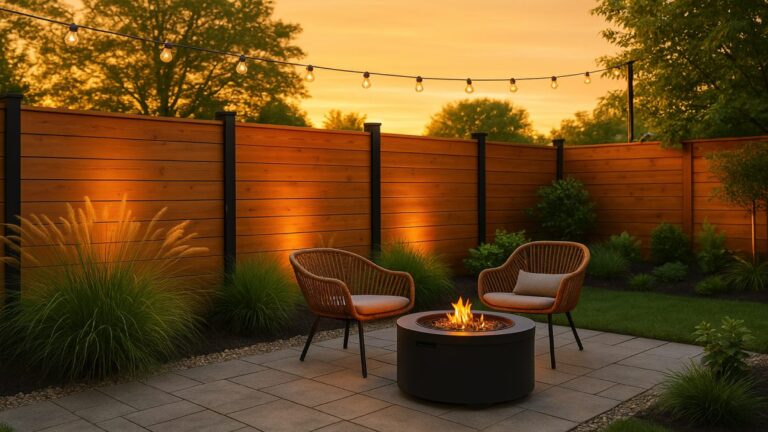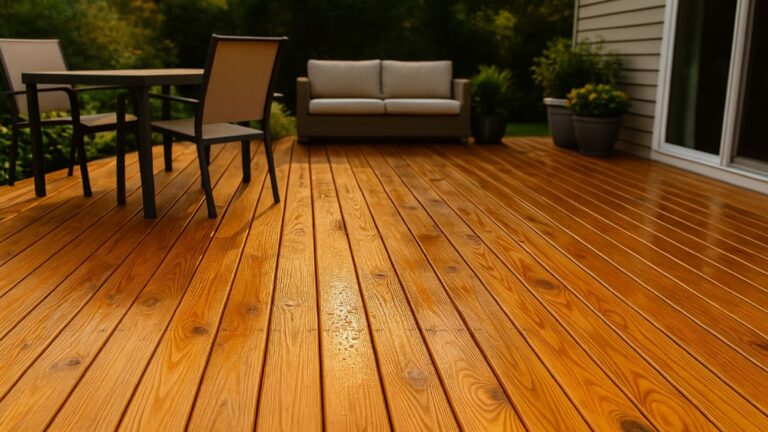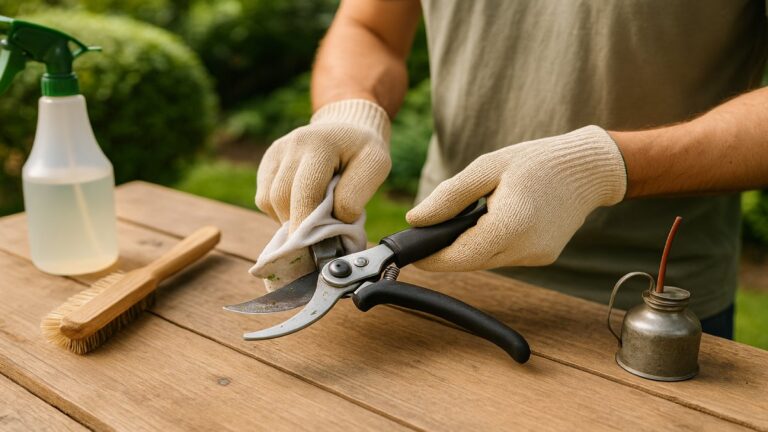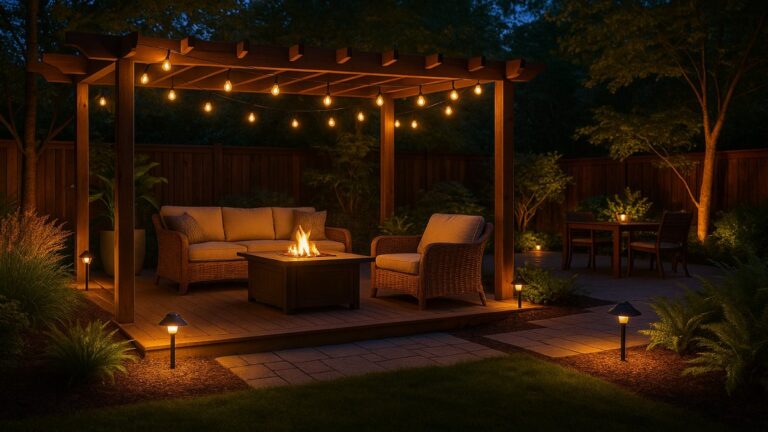Best Outdoor Paints for Furniture & Wood Fences: 2025 Guide
Outdoor paint does far more than change color—it seals out water, resists UV damage, and shields wood fibers from swelling, cracking, and rot. The right system (prep + primer + topcoat) can stretch the life of garden benches, Adirondack chairs, deck boxes, and full fence lines by years, while the wrong product can peel in a season. This guide breaks down finishes by chemistry and use-case, explains how to prep different substrates, and shows you how to apply and maintain a finish that stays crisp through sun, rain, and freeze-thaw cycles.
Below you’ll find practical, brand-agnostic advice written for real-world conditions—humid summers, coastal salt air, high-altitude UV, and the occasional “I only have Saturday afternoon” project window. Use the comparison sections to pick the best paint for wood furniture versus long fence runs, then follow the step-by-step instructions to get professional results with DIY tools.

What Makes an Exterior Paint Last Outside
Exterior paints live a tough life. Moisture, UV, and temperature swings try to break down the film and the wood beneath it. A great outdoor coating balances three things: adhesion (so it doesn’t peel), flexibility (so it moves with seasonal expansion/contraction), and weather resistance (so gloss and color don’t chalk or fade). Modern waterborne formulas also aim for low odor and faster dry to recoat.
Key durability drivers
- Resins/binders: 100% acrylics and waterborne alkyds give strong adhesion, block moisture, and resist UV. Oil/alkyds cure very hard but can embrittle over time.
- Pigments & UV package: High-quality titanium dioxide and UV absorbers minimize fading and chalking; deeper colors often need premium lines for fade resistance.
- Film build: Two to three thin coats beat one heavy coat. Primer + topcoat creates a moisture-resistant sandwich.
- Breathability: Coatings that allow limited vapor escape reduce blistering on fences and furniture that occasionally get wet.
The Best Paint Types for Furniture vs. Fences
Different substrates and wear patterns call for different chemistries. Chairs and tables receive hand oils, abrasion, and dings. Fences face wind, sun, and moisture with big seasonal movement. Here’s how popular options stack up.
100% Acrylic Latex (Waterborne Acrylic)
Best for: Most wood fences; outdoor furniture in moderate climates. Why: Excellent flexibility, strong adhesion to properly primed wood, easy water cleanup, and fast recoat time. Quality acrylics resist peeling and hold color/gloss well.
Waterborne Alkyd (Alkyd-modified Acrylic)
Best for: Furniture that benefits from a smoother, harder, more scrubbable finish (e.g., tabletops, armrests). Why: Oil-like leveling with water cleanup and better non-yellowing than traditional alkyds. Great balance of hardness and exterior durability.
Traditional Alkyd/Oil
Best for: Select applications where deep penetration and blocking of wood tannins is needed. Caveats: Longer dry times, higher VOC, and potential yellowing. Can be durable but less flexible; not ideal where significant expansion/contraction occurs.
Solid-Color Stain (Technically a Coating)
Best for: Long fence runs and rough-sawn or weathered boards. Why: Easier recoats with less scraping than paint, strong UV resistance, and better breathability. Delivers an opaque look like paint but often with simpler maintenance.
Urethane-Fortified Acrylics
Best for: Furniture that needs scuff resistance (bench slats, picnic tables). Why: Added mar resistance and toughness while keeping waterborne benefits.

Finish & Sheen: Where Satin, Semi-Gloss, and Flat Fit
Sheen affects appearance and cleanability. Higher gloss levels reflect more light and typically resist dirt better; lower gloss hides surface flaws but can hold grime in textured wood.
- Satin: The outdoor sweet spot for most wood. It hides minor imperfections, sheds water, and cleans up without looking too shiny.
- Semi-gloss: Extra stain resistance for tabletops and armrests; expect to see more surface texture and brush/roller pattern if substrate isn’t well sanded.
- Matte/Flat: Beautiful on modern fences and large surfaces you want to visually “push back.” Use premium exterior flats designed to resist chalking and dirt pickup.
Color & Fade Resistance Outdoors
Whites, off-whites, and light grays typically last longer before noticeable fading. Deep, saturated hues (navy, forest green, charcoal) can look stunning but require fade-resistant lines and careful maintenance in high-UV regions. When in doubt, choose a premium exterior series with explicit sun resistance and plan periodic rinsing to limit surface chalk/dust that accelerates fade.
Surface Prep: The Foundation of Longevity
Preparation is 70% of a lasting job. Paint only adheres to what it touches—dirt, gray oxidized fibers, and glossy old coatings are weak links. Refinishers who nail prep routinely get 5–10 years from good systems; skipping a step can cut that in half.
Prep checklist for bare or weathered wood
- Clean: Scrub with a mild exterior cleaner or wood wash to remove dust, pollen, and mildew. Rinse thoroughly and let dry.
- De-gloss or sand: Break the polish of existing finishes with 120–150 grit; feather peeling edges to a smooth transition.
- Repair: Set or replace rusted fasteners, tighten loose boards, and fill small checks/holes with an exterior wood filler or epoxy, then sand flush.
- Spot prime knots/tannins: On cedar/redwood, use a stain-blocking primer to reduce bleed-through.
- Prime: Use a compatible exterior primer to equalize porosity and promote adhesion.
When light sanding is enough
If the previous coating is sound (no peeling or bubbling), wash, de-gloss, and scuff-sand. Prime only bare spots and any sapwood/knots, then topcoat with a high-quality exterior paint.
Primers That Solve Real Problems
- Stain-blocking primers: For cedar, redwood, and over water stains or knots.
- Bonding primers: For slick, previously painted surfaces where sanding is limited.
- Moisture-tolerant primers: For fence posts and lower boards that get splashback or dew.
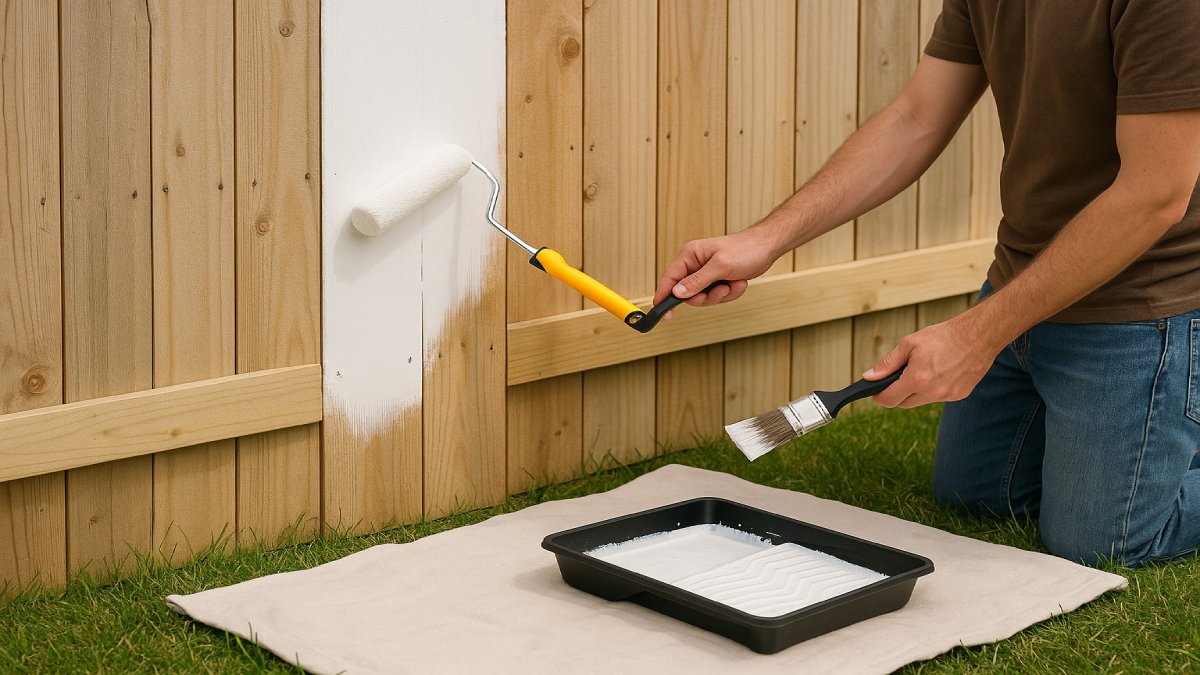
Application Methods: Brush, Roller, or Sprayer?
Choose the tool that matches the surface and your setup time. Brushing drives paint into grain on furniture and narrow rails. Rollers cover fence fields fast. Sprayers excel on large, complex areas if you can mask properly.
Brush & roller tips (DIY-friendly)
- Brush: High-quality synthetic bristles for waterborne paints; load generously and tip off in the grain direction for fewer marks.
- Roller: 3/8″ nap for smooth planed wood; 1/2″ on rough-sawn boards. Back-brush to press paint into pores.
- Coats: Two thin finish coats over primer. Respect recoat windows listed on the can.
HVLP or airless sprayer (fast but prep heavy)
- Mask adjacent hardscape, plants, and hardware; shield neighboring properties on breezy days.
- Maintain wet edges and back-roll/back-brush onto rough grain for penetration.
- Strain paint, dial the fan pattern, and test on scrap to avoid sags.
Climate & Timing: Paint When the Weather Helps
Most exterior paints prefer 50–90°F (10–32°C), moderate humidity, and shade. Avoid painting under direct midday sun, right before rain, or on dew-prone evenings.
- Sun: Work the shaded side of the fence/yard; lap marks and flashes happen in blazing sun.
- Dew: Stop early enough that film can set before nightfall; dew can flatten gloss and cause surfactants to streak on fresh waterborne films.
- Wind & dust: Light breeze is fine; high wind ruins spray patterns and blows debris into wet paint.
Project Walkthroughs
Refinishing a weathered wood fence (solid color look)
- Wash and rinse boards; allow to dry completely.
- Scrape/feather any loose paint; sand glossy areas.
- Spot-prime bare wood, knots, and end grain.
- Roll field boards with quality acrylic or solid-color stain; back-brush for penetration.
- Brush rails, posts, and cut-ends; add a third coat on high-exposure sides.
Painting outdoor wood furniture (smooth, durable finish)
- Remove hardware/cushions; clean surfaces and rinse.
- Sand to 150–180 grit, vacuum, and tack cloth.
- Prime fully for uniform build and bonding.
- Apply two thin coats of waterborne alkyd or urethane-fortified acrylic; finish critical wear zones (armrests, seats) with a third coat.
- Allow a full cure window (often 5–7 days) before heavy use.
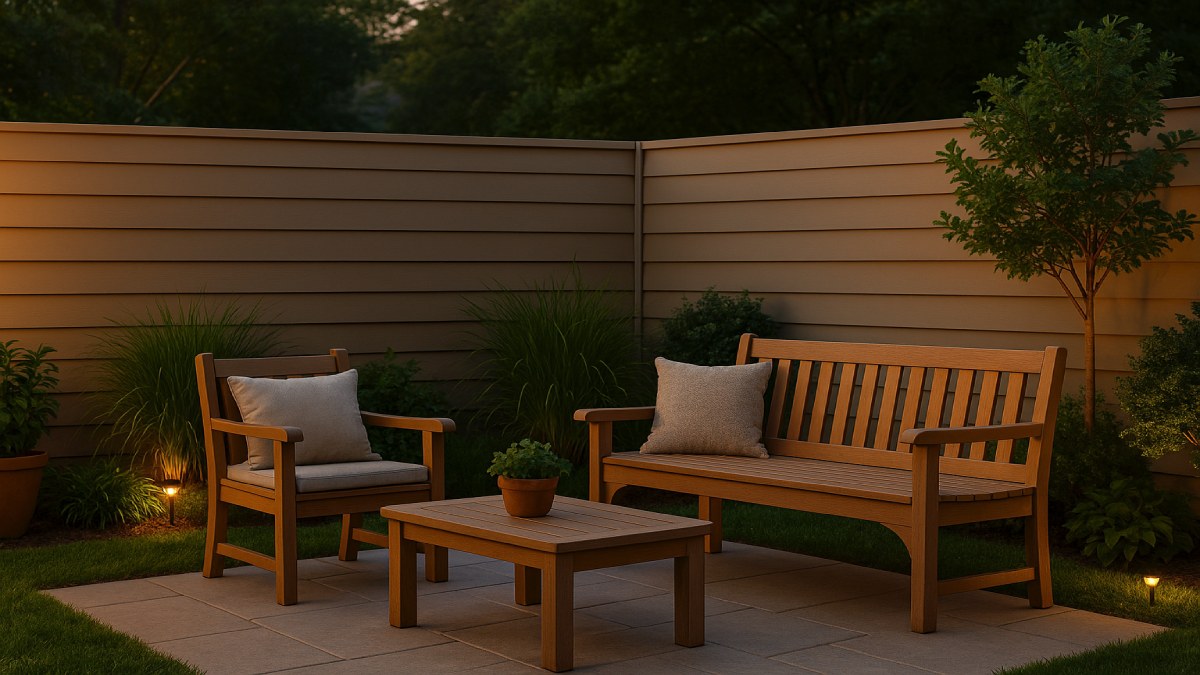
Common Pitfalls (and Easy Fixes)
- Peeling within a year: Usually poor prep or moisture trapped behind the film. Solution: remove failed areas, dry the substrate, use a bonding or stain-blocking primer, and recoat in mild conditions.
- Tannin bleed/yellowing spots: Common with cedar/redwood if unprimed. Spot sand and prime with a stain-blocker; apply another finish coat.
- Roller stipple on furniture: Level with a light sand (220–320) and brush a thin, flowed-out coat; consider waterborne alkyd for better leveling.
- Fading on dark colors: Rinse surfaces seasonally to remove chalk; choose fade-resistant lines and consider slightly lighter hues.
Maintenance Schedule to Extend Lifespan
Good coatings don’t need constant attention—just smart touchpoints through the year.
- Every 3–4 months: Rinse dust/pollen buildup; spot clean food or plant stains.
- Spring & fall: Inspect end grain, post caps, and horizontal ledges; touch up hairline checks before water gets in.
- Every 2–4 years (furniture): Light scuff and refresh the topcoat on high-wear areas.
- Every 4–7 years (fences): Recoat sun-blasted sides earlier than shaded runs; solid-color stains often recoat more easily than paint.
Eco & Safety Notes
- Low-VOC lines: Modern waterborne paints offer low odor and reduced VOCs without sacrificing durability.
- Lead safety on very old coatings: If you suspect lead, use safe preparation methods and consult local guidance before sanding/scraping.
- Cleanup: Keep wash water out of storm drains; wipe brushes and rollers before washing to minimize residues.
Budget Tiers: Where to Spend
- Entry level: Acceptable for short fence panels in mild climates; expect more frequent recoats and a bit more color fade.
- Mid-range: Best value for most homeowners—good UV resistance, workable open time, and reliable adhesion.
- Premium: Top UV inhibitors, better color retention, and smoother leveling for furniture. Worth it for dark colors and harsh sun belts.
Quick Selection Matrix
| Use-Case | Recommended System | Sheen | Why It Works |
|---|---|---|---|
| Long fence run (rough-sawn) | Primer + solid-color exterior stain (acrylic) | Flat–Satin | Breathes, easy recoat, hides imperfections |
| Furniture (smooth finish) | Bonding primer + waterborne alkyd | Satin–Semi-gloss | Harder, smoother film; scrubbable |
| High-touch tabletops/armrests | Primer + urethane-fortified acrylic | Semi-gloss | Improved mar and stain resistance |
| Harsh UV/dark colors | Premium acrylic with UV package | Satin | Better color and gloss retention |
Pro Tips for Flawless Results
- End-grain first: Seal cut ends and post tops with primer before broad coats. That’s where water sneaks in.
- Thin coats win: Heavy coats skin over and trap solvents/water, which weakens the film. Aim for even, thin passes.
- Maintain a wet edge: Work in logical sections and back-brush quickly to level out roller texture.
- Strain your paint: A cheap mesh cone saves you from nibs that telegraph through sunlight.
- Let it cure: “Dry to touch” is not “ready for cushions.” Observe cure time before heavy use.
FAQs
Is paint or solid-color stain better for fences?
Both protect well. Solid-color stain often wins for easier recoats and breathability on large, weather-exposed surfaces. Choose paint when you want a smoother, more architectural look and are willing to invest in fuller prep.
Can I use the same product on furniture and fences?
You can, but you’ll usually get better performance by matching product to task: waterborne alkyd for smooth furniture; acrylic or solid-color stain for big fence runs.
What’s the best sheen outdoors?
Satin is the universal crowd-pleaser outdoors—easy to clean, not too shiny, and forgiving on wood texture.
Do I need to sand to bare wood?
Only where the old finish has failed or you’re changing systems. A sound, de-glossed, and clean surface with spot priming is usually adequate.
How often should I recoat?
Furniture in full sun may need a refresh in 2–3 years on high-touch areas. Fences typically go 4–7 years depending on color, exposure, and product line.
Conclusion: Build a System, Not Just a Color
The best outdoor paint projects succeed because of the system, not a single miracle can. Prep thoroughly, use a compatible primer, select a finish chemistry that matches the job, and apply thin, even coats in friendly weather. With a quick seasonal rinse and small touchups where water wants to enter (end grain and horizontal ledges), your furniture and fences will look intentionally designed—and stay protected—for years.

